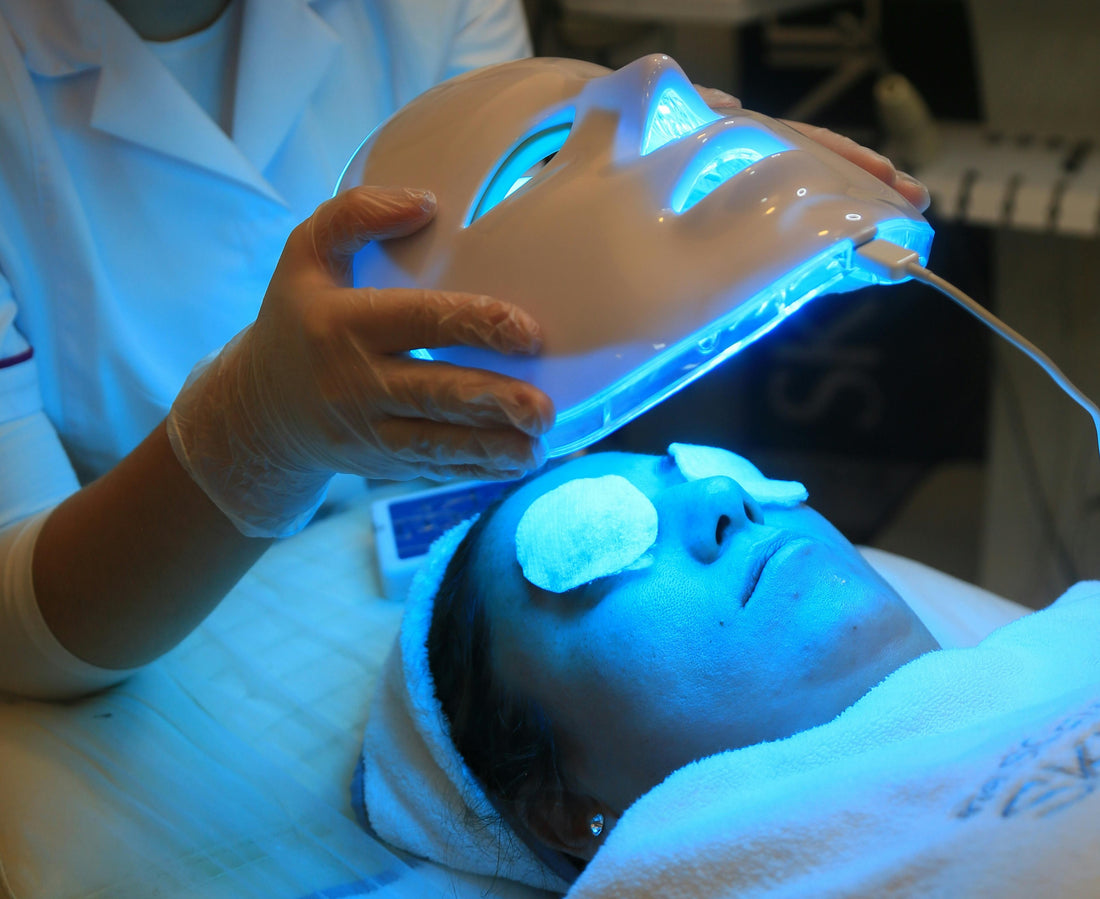
Blue Light Therapy
Share
Blue Light in LED Masks, Can they Reduce Bacteria? The Science Behind the Glow
In recent years, LED masks have become increasingly popular, especially in the world of skincare. These masks use light therapy to address various skin concerns, from acne to fine lines. One of the most talked-about features of these masks is their ability to use blue light to fight bacteria, specifically the acne-causing bacteria Propionibacterium acnes (P. acnes). But how exactly does blue light help reduce bacteria on your skin? Let's dive into the science behind it.
What Is Blue Light Therapy?
Blue light therapy is a non-invasive treatment that involves exposing the skin to a specific wavelength of light, typically in the range of 400–450 nanometers. This range of light is known for its ability to penetrate the skin and target harmful bacteria that live on the surface.
LED masks designed for skincare harness blue light's power (not the same as the not-so-good one your phones and other devices emit), emitting it directly onto your skin. The light is absorbed by the skin's surface layers, where it can work its magic to fight bacteria, reduce inflammation, and promote clearer skin.

How Does Blue Light Kill Bacteria?
Blue light works by generating reactive oxygen species (ROS) when it interacts with the skin. These reactive molecules, particularly singlet oxygen, have antimicrobial properties. When blue light is absorbed by the skin, it stimulates the bacteria in the follicles to produce these ROS. The ROS then attack and damage the bacteria's cell membranes, leading to their destruction.
One of the main targets of blue light therapy is P. acnes, the bacteria often responsible for causing acne. P. acnes thrives in the hair follicles and pores, feeding on the oils your skin produces. When these bacteria proliferate, they can cause inflammation, which leads to breakouts. By using blue light, the LED mask reduces the population of these bacteria, effectively reducing the chances of acne forming.
Why Is Blue Light Effective Against Acne-Causing Bacteria?
-
Targeting the Source: Acne is primarily caused by bacteria that live on the skin and in pores. Blue light therapy targets these bacteria without affecting the surrounding healthy skin cells. By attacking the root cause of acne, blue light provides a targeted and effective treatment.
-
Non-Invasive: Unlike some treatments that involve harsh chemicals or invasive procedures, blue light therapy is gentle and non-invasive. It doesn’t involve the use of needles or prescription drugs, making it a safer option for many people.
-
Anti-Inflammatory: In addition to killing bacteria, blue light can also help reduce inflammation. This dual effect means that it doesn’t just treat the acne itself but also helps to calm the skin, making it less red and irritated. This is particularly beneficial for those with sensitive skin.
-
Clinically Proven: Studies have shown that blue light therapy can reduce acne lesions and bacteria levels, providing a noticeable improvement in skin texture and clarity. Many LED masks are now backed by clinical research that supports their effectiveness in fighting acne.
Other Benefits of Blue Light Therapy
While blue light is widely recognized for its ability to reduce bacteria and help with acne, it offers other benefits as well. Some users report improvements in their overall skin tone and texture, as well as a reduction in the appearance of pores. Blue light is also believed to stimulate the production of collagen, which can improve the skin's elasticity and reduce the appearance of fine lines and wrinkles over time.
Using Blue Light LED Masks for Acne
If you're considering trying an LED mask with blue light to reduce bacteria and fight acne, here are a few tips:
-
Consistency is Key: To see results, it's important to use the mask regularly. Most recommendations suggest using the mask for 10-20 minutes per session, several times a week. However, always follow the instructions provided with the specific mask you're using.
-
Cleanse Before Use: For maximum effectiveness, make sure your skin is clean before using the LED mask. Remove makeup, dirt, and oil to ensure that the blue light can directly target the bacteria on your skin.
-
Patience: Like most skincare treatments, blue light therapy doesn’t deliver overnight results. It may take a few weeks of consistent use to see a noticeable reduction in acne or improvement in skin clarity.
-
Protect Your Eyes: Always keep your eyes closed and protect your eyes by placing cotton buds over them or some other form of eye protection, as prolonged exposure to blue light can strain the eyes. Many LED masks come with protective goggles or recommendations on how to shield your eyes during the treatment.
Closing Thoughts
Blue light therapy in LED masks offers an innovative, non-invasive way to reduce acne-causing bacteria and improve skin health. By using blue light to target P. acnes bacteria and reduce inflammation, LED masks provide a simple, effective solution for clearer skin. Whether you're struggling with acne or simply looking to enhance your skincare routine, blue light therapy may be a helpful addition to your daily regimen. With regular use, you may see fewer breakouts and smoother, healthier skin.
So, the next time you put on your LED mask and feel the calming glow of blue light, you can rest assured that it's working hard to reduce bacteria and keep your skin looking its best.
More and more scientific and social studies are showing real results of this non-invasive form of light therapy. LUXE's mask if specifically designed to allow this form of therapy to everyone, at an affordable price. There is less and less research suggesting that expensive LED Mask options actually provide better results, as the technology is the same.
Try for yourself: https://luxeskinandhair.com/products/led-face-mask-rechargeable





